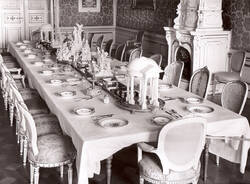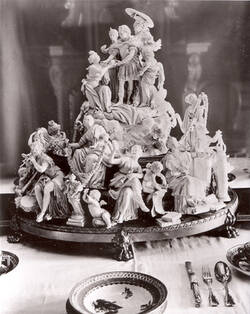This figural group on a round pedestal was just the central element of a vast table centrepiece originally seven metres long. The centrepiece was a gift for Elector Friedrich August III of Saxony, presented to him in Dresden in 1776 on his 26th birthday. The ensemble is remarkable for its combination of white porcelain with colourful gemstones from Saxony. The main figures extol the young ruler’s virtues – benevolence, compassion, and military prowess. The female figures around the base are the Muses, the goddesses of the arts and sciences flourishing under his rule.
Further Media



Even today, people like to decorate a table for a festive meal. But our efforts pale into insignificance in comparison to eighteenth-century table decorations. A festive meal in the baroque period was a grand affair. Elaborately staged, this carefully orchestrated performance unfolded in several acts following a strict ceremonial protocol – after all, this was not just a meal, but an act of state. No detail, however small, could be left to chance. Every object, every gesture was significant, and everything and everyone had a precisely defined place.
The festively decorated table was like the stage – the centre of the performance. The various dishes were suitably presented on bowls and plates, according to exactly prescribed models. The tureens were the eye-catchers on the laid tables, while the middle of the table was marked by a centrepiece holding salt, pepper, oil, mustard and lemon to season the food. Since the host’s status and wealth were reflected in the extravagant luxury of the setting and the meal, on festive occasions a ruler would have the food served on gold or silver plates. From the mid-1730s, Meissen porcelain dinner services with their brightly colourful designs became fashionable among the nobility. In this way, court nobles could show off with sensational novelties, without outdoing their rulers.
Dessert was the high point of every festive meal. Since protocol for this course was more relaxed, Elector Friedrich August II could introduce a practice of serving the desserts on porcelain, turning his festive table into a stage to present the much-coveted porcelain from his Meissen Manufactory. In 1747, when his daughter Maria Anna married Maximilian III Joseph, the Elector of Bavaria, the festive banqueting table was not only decorated with a large temple of Diana and various mythological and allegorical figures, all made of Meissen porcelain, but also replicas of the Bavarian palaces at Nymphenburg and Lustheim together with their parks and gardens.
- Location & Dating
- Meissen, 1775
- Material & Technique
- Porcelain, unpainted, gemstones, wood, gilt bronze
- Dimenions
- H. 75,0 cm, B. 80,0 cm, T. 73,0 cm siehe Einzeldatensätze PE 1656 a-1656 r.
- Museum
- Porzellansammlung
- Inventory number
- PE 1656